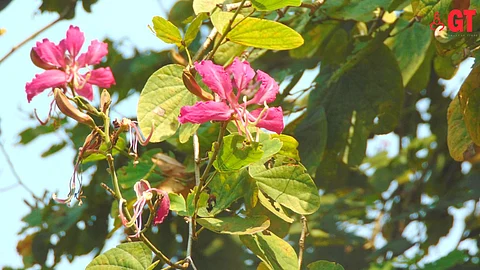

It is believed that any festival is a representation of a particular religion and culture. But, when we look minutely, we will realize that it is also the representation of the biodiversity of the place where this festival is celebrated.
Today, as we celebrate the festival of Dussehra/Dasara or Dasro — which represents the triumph of good over evil — let’s look at the way it incorporates various elements from biodiversity.
FLOWERS & LEAVES
On this day, every Hindu household and even vehicles are decorated with a garland of marigold and mango leaves. These leaves are considered auspicious and are, thus, part of many rituals. Marigold flowers, locally known as roza, bloom at this time of the year, soon after the monsoons. Due to their strong fragrance and vibrant colours of yellow and orange, they are used for making garlands.
On this day, there’s also a tradition of exchanging leaves of the Bauhinia or aapto tree as it symbolizes gold. The botanical name of this tree is Bauhinia racemosa, which is also mentioned in various mythological stories.
One may wonder why leaves are exchanged on this day? There are many stories associated with this. One story is related to the epic Mahabharata and states that the Pandavas incognito buried their weapons under this tree, during their one year exile.
However, the jury is out regarding which sacred tree it is.
It is commonly believed, at least in the states of Maharashtra and Goa, that the leaves of Bauhinia are exchanged, as they symbolize prosperity.
However, there are 7 species of Bauhinia. The book, Trees of Delhi by Pradip Krishen, lists another one – Bauhinia x blakeana – which is a natural hybrid first discovered in S China. It is known as Hong Kong Orchid Tree and has bright red flowers.
Among the seven native species, some are trees, some are shrubs and one is a creeper, and all belong to the Caesalpiniaceae or legume family.
In Goa, four species of Bauhinia are found. To a lay man, they may look like regular leaves, but the leaves of these trees resemble a cow’s or camel’s hooves or are heart-shaped.
BAUHINIA IN GOA
The most common variety is the Bauhinia recemosa, which is known as Aapto in Konkani, or the bidi leaf tree, with drooping branches as its leaves are used to roll bidis. It is also medicinal. It usually flowers from February to May and it has a bunch of small whitish flowers of 1 centimeter each.
The other species is Bauhinia vahlii, which is known as Maloo creeper and is the largest creeper found in India. It has large leaves of 10-45 cm, and white flowers which turn yellow with time. It is usually found in North India in the Himalayas and are not a part of this region.
But in Goa, they are easily seen at Karmal Ghat on the way to Canacona. Here, they grow profusely and has big leaves, almost 12 inches in length. Locally, these leaves are sometimes used to make plates.
In urban spaces of Goa, two species of Bauhinia are commonly found. The first one is Bauhinia purpurea, or purple orchid tree as it has purple coloured flowers, shaped like orchids. These flowers are quite fragrant. This starts flowering in the month of October-November.
The second species is Bauhinia variegata. You may assume that they are the same species, but, when you examine its flowers, you will discover that they are different species. It has pretty pink flowers and starts flowering now. Also the young buds of the variegata tree are edible and a seasonal vegetable is made from it, especially in North India. It is locally known as Kachnar and it is a seasonal delicacy there. Sometimes pickle is also made from it.
The other species are Bauhinia tomentosa or Yellow Orchid Tree; Roxburgh’s Bauhinia or Semla. Its botanical name is Phaneraretusa; Bauhinia acuminata or the Dwarfwhite bauhinia. It is a shrub and has pretty, big, white flowers. It is also found in Goa. It has a sweet fragrance and is also considered medicinal.
Coming back to the point, which is the sacred tree, there’s another species and it holds lot of significance in rural parts of Canacona. In the village of Mashem, Canacona, there’s a tradition of worshipping a forest species called Kadamb during the annual Dussehra festival, and not the bauhinia tree, which is usually associated with the festival.
On the day of Dussehra, the ritual of Tarangas is held at Mashem village. This ritual is held in two village temples, and the ritual culminates with a procession that goes through the forest and collects leaves of this true Kadam tree. It is neither the aapto tree nor the Kadamb tree (Neolamarckia cadamba), which we come across around urban spaces.
This true Kadamb is a forest species and its botanical name is Mitragyna parvifolia. The confusion could be because of its flowers as both these trees (Kadamb and true Kadamb) have circular ball-shaped flowers, which makes Kadamb trees distinct. This tree is also medicinal.
Along with these two trees, in other parts of the country, like in Tamil Nadu, Telangana, there is a tradition of exchanging leaves of Khejri (Prosopis cineraria) tree. This tree is usually found in dry areas and can grow in adverse conditions, also.
All these trees are considered medicinal and an important species of the local biodiversity. This shows that our forefathers knew the importance of these trees and they are, thus, a part of our rituals. The species also tends to change according to location as any festival is a direct representation of its land and, thus, takes elements from it while celebrating.
This also shows how connected we are to our ecology, and there is a need to celebrate it by understanding more about it, growing native species and, most importantly, conserving our forests and their biodiversity.